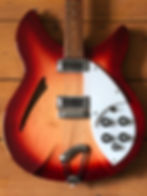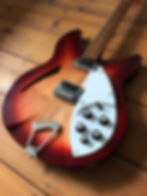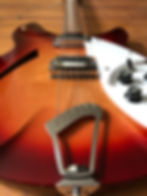1989 Rickenbacker 330/12 Fire-glo, as made famous by Johnny Marr
Not quite as old as Johnny Marr's 60s model, previously owned by Phil Manzanera of Roxy Music. But with that timeless design and that instantly recognisable sound, the choice of the decade is completely yours!
OK, call me predictable, but the first song I picked out on this guitar when I got it home was The Byrds' version of Mr Tambourine Man. It may have been Bob Dylan's song, but with that utterly unique 12-string tone, Roger McGuinn made it his own. Like George Harrison, he was famous for the more deluxe model, the 360/12, but that sound is just unmistakeable, and players from Pete Townsend to Johnny Marr and Paul Weller to The Edge have found ways to mix that sound with their own unique styles. Who'd have thought that the opening auto-wah chords to U2's Mysterious Ways were played on a 330/12? Not me - but check out The Edge's rig rundown in the videos below and all is revealed.
Of course, I've chosen Johnny Marr for the "as made famous by" tag. Johnny used it primarily as a studio guitar (check out The Headmaster Ritual for a start), though live performances are limited, and more for the look than accuracy. First spotted in his hands on Top Of The Pops to This Charming Man - which I'm pretty sure was recorded on a vintage Telecaster. Still, Rickenbackers were the defining look for Johnny in the early days of The Smiths. The official video for This Charming Man features a Jet-glo Rickenbacker 330 - more on that one here.
This 1989 model may have been born at Rickenbacker's Santa Ana home, but it first came to market in New Zealand. Bought new from CJ's Guitar Store (now MusicWorks) in Christchurch by Mike Gregg of The Holy Toledos, this guitar has led a life that has crossed the globe. Every guitar has a story, and I'm indebted to Andrew Benbow, who sold this guitar to me, for all the detail in filling out the story for this one. See below for more. It's a guitar that's aged through studio and live play, with all the mojo that comes from a life well-lived. All original, with one exception. The "R" logo tailpiece may be iconic, but it's not indestructible, and there are a few stories out there of exploding tailpieces, even on newer models. This is one of those stories. But I've decided to stick with the non-original harp tailpiece that was on it when I got it - it's part of the story, and it works perfectly. You may, too, fall straight into Mr Tambourine Man when you pick this up, but that's just the start of the adventure. Wonderful sound, perfect icon!
See & Hear It In Action

-
Forget And Forgive, The Holy Toledos (1991): The guitar in the hands of its original owner, Mike Gregg of The Holy Toledos, on their debut album Forget And Forgive. From the opening chords of I Confess, you know you're tuned into this 330/12. Such a sound!
-
This Charming Man (1983): Well, I'm pretty sure it's for the look rather than what the song was recorded on, but even so, you can't argue with how very charming Johnny's 330/12 looks here.
-
Music Store TV 330/12 Demo (2011): Thank you, Music Store TV - pretty much every iconic song ever to come out of a 330/12 and its more deluxe versions! Glorious ringing tones.
-
The Edge's 330/12s, And A Lot More! (2018): Guitar tech, Dallas Schoo, takes Premier Guitar through The Edge's collection. Check out the story behind Mysterious Ways when he runs through the 330/12s from 14:36 in. And if you've an hour to spare, watch the whole video. It's an Aladdin's Cave!
-
We Are Together Christmas Anthem, Kevin Connery (2023): 2023 was the first year that guitars from the collection featured on a Christmas single - in fact, not one, but two! Recorded using two 12-strings, including this 330/12, here's Kevin Connery's uplifting Christmas single, We Are Together. All proceeds to MacMillan Cancer Charity. Listen & download for charity now! And check out Michael Fitzgibbon's Christmas Winds for some vintage 6-string seasonal warmth!
Feedback
The Story
It's rare that I get to write the story for a guitar that's not been in the hands of a more famous guitarist. Not for want of trying, but unless the guitarist is in the super-league, there's usually very little information available about a guitar's previous players and appearances. Which is a shame. Because all guitars that aren't straight off the production line have a story. Chances are that almost every guitar is picked up by a guitarist, novice or experienced, learning their first chords or wanting to expand their sound and style - and almost always with a dream that one day they'd join the guitar gods that inspired them in the first place. It's the guitar that makes that dream a reality.
So I'm hugely grateful to Andrew Benbow for not only selling me this guitar, but also for filling in the story from the day it was first bought by his childhood chum Mike Gregg. Andrew and Mike were schoolfriends in Christchurch, New Zealand, shared the same dream, and formed a band in the late-80s. Some first bands last. And others splinter and reform into new bands. Which is what happened, with Andrew forming Black Spring and Mike forming The Holy Toledos. Both bands cut their first EPs in 1989. And while Andrew came to the UK to pursue his own dream, The Holy Toledos stayed in New Zealand, playing, writing, crafting their songs, producing their first album, Forget And Forgive, in 1991. Like so many first albums, recorded in just one week - and all the more immediate and fresh for that.
The Holy Toledos weren't shy of sharing their love for the Rickenbacker sound - check out the few videos there are of them and it's Rickenbackers across the line-up. Mike fell in love with this 330/12 while working at CJ's Guitar Store (now MusicWorks) in Christchurch. And it plays a big part on the first album - just let those opening chords to first track I Confess ring out, and you know it's this 330/12.
The band may not have broken the global market, but if you were living in Australia or New Zealand in the early-90s, you'd definitely have heard of them. They supported fellow antipodeans turned global stars Crowded House in 1992 and Split Enz in 1993. Paul Hester of Crowded House even produced their second album, Blood, in 1993, once they'd signed to Sony. They worked hard. This guitar was a touring companion as much as a studio guitar. So hard that at one point the guitar headstock developed a split at the crown edge - sympathetically and solidly fixed by a local luthier. Good for the guitar, but without their own ticket to more global recognition, Mike and the rest of the band went onto different projects - without officially breaking up - in 1994.
Which brings Andrew back into the story. He returned to New Zealand in 1996 and bought the guitar from Duncan Hann, a school friend of his younger brother. Duncan was playing in a local "Irish punky bar band", originally called The Black Velvet Band, before changing their name to The Tullamores. Brothers Mike and Brendan Gregg had joined The Tullamores, and Duncan had bought the guitar from Mike. Andrew then started up a three-piece band, Up Periscope, cutting tracks in both Christchurch and London, using the 330/12 on both occasions - in London recording the wonderfully titled EP, Up Periscope Plays This Is Ski Bob Austria, in 2000.
While the guitar then took more of a back seat, it made an appearance every once in a while. And it was while on loan to London-band Souther Still that the original "R" logo tailpiece exploded. Sadly, the band didn't keep the broken tailpiece - though they did think they could turn it into a belt buckle. If you've ever tried getting a replacement part from Rickenbacker - particularly something as iconic as they "R" logo tailpiece - prepare yourself for an inquisition . . . With some understatement on Wikipedia, "Rickenbacker are known for their pro-active approach to preventing the sale of copies or 'clones' of their instruments." Unless you've got the original broken part, Rickenbacker won't release a replacement. It's a pity, but I'm sticking with the replacement harp tailpiece that this one comes with. It works perfectly, and it isn't very often you can tell a story about an exploding tailpiece.
So, there you have it. A global traveller, three owners, four bands, tours with global stars, appearances on multiple recordings, and an exploding tailpiece. The type of story (apart from that tailpiece) that any guitar that's been on this planet for more than a few years could tell, if only it could talk. More often than not, it's just the feel and the sound that can talk to us. Which, come to think of it, is exactly the reason the reason they have such a story to tell.
Specification
Make
Rickenbacker
Model
330/12
Colour
Fire-glo
Year
1989
Serial Number
H2 7682
Number of Frets
24
Fretboard
Varnished Rosewood
Neck
Maple
Body
Carved Maple
Tuners
Schaller Mini
Pick-ups
Rickenbacker Hi-gain
Bridge
Rickenbacker Bridge & Cover
Tailpiece
Non-original Harp Tailpiece
Scale Length
24.75"
Full Length
39.75"
Further Information:
-
Of all the major manufacturers, Rickenbacker fully deserves the archivist's Oscar - by far the most comprehensive collection of specs, brochures and history. Even down to the component numbers for each of the parts that goes into each guitar.
-
Which means there isn't that much to add to what Rickenbacker has already said. But the story behind that ingeniously designed headstock is worth a mention. Back to 1963. The brief from Rickenbacker owner F C Hall to designer Dick Burke was to come up with a way of making the turners for a 12-string fit onto a headstock for a 6-string - as opposed to most 12-string guitars that just extended the headstock to incorporate 6 tuners in series. Burke's design was an act of genius, retaining the normal 6 tuners on the side of the headstock, and then partially routing out the headstock front to make space for the spindles of the additional 6 tuners, which sat at 90 degrees to the first set of tuners. It works! Though, when it comes to restringing, you'd better have a sequential plan, and as a friend has suggested, a fridge full of beers to hand.
-
Apart from that. the rest is classic Rickenbacker. The narrow neck, that lovely Rickenbacker bridge assembly, the Rickenbacker Hi-gain pick-ups, and that Tone Mixer knob all combine to give this guitar a playability and range of tone that goes beyond just the classic "jangly" sound it's know for. Though, to be fair, it definitely has that "jangle" in spades.
-
This is a great guitar. It's not for bends or fast riffs - but no 12-string is. But for strummed or picked chords and melodies, it's utterly brilliant, and utterly distinctive. Guaranteed to add depth and dimension to whatever song you put it to!
Sources & Links
-
Rickenbacker Thinlines, Guitar HQ: Always a fantastic source for all the detail you could imagine or would forget to ask for, Guitar HQ takes us through all the Rickenbacker Thinlines, including the 330/12. Invaluable!
-
Today's Rickenbacker 330/12 . . .: . . . looks no different to yesterday's. If you've got the winning formula, why change it? Rickenbacker knows.
-
Johnny Marr's 1960s Rickenbacker 330/12 Fire-glo: Page down through the brilliantly researched Smiths On Guitar to find the story behind one of Johnny Marr's most iconic guitars from The Smiths years. And spend more time on the page - the best website for insights into Johnny Marr's (and Andy Rourke's) gear.
-
2009 Rickenbacker 330/12 Review: A great review on Ultimate Guitar - dispels some myths, unearths some gold, and shares what a versatile guitar this is . . . once you get past Mr Tambourine Man.

















